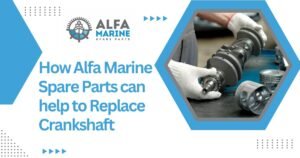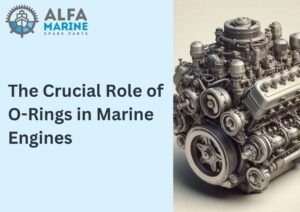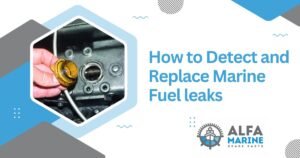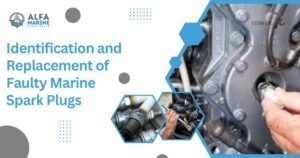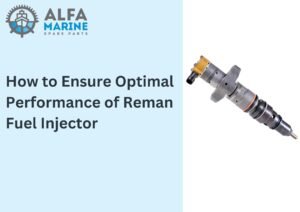Marine diesel engines have several components. Even when components change design, their function stays the same. Each part has a purpose and placement. You probably already know something about them, especially if you’ve assembled them before.
For some who previously understood, it would be a review; for others, it’s vital to know engine spare parts to grasp “marine diesel engine.” If you want more specifics, I propose “Marine Diesel Engine” by Nigel Calder.
11 Main components that make up the engine and they are as follows:
- Bedplate
Two parallel girders make up a bedplate. “Transverse Girders” link them. It’s between the crank throw and trust collar. Transverse girders have cast-steel bearing supports.
Aft-most transverse girders are designed and built for rigidity. This is the variable-thrust portion. Bedplates are made by welding cast steel transverse girders between longitudinal girders with bearings and tie bolt holes. Small engines use cast iron.
- Crankshaft
A crankshaft undergoes severe torsion, bending, and shear stress. Crankshaft is made of silicon (0.3%), carbon (0.2%), sulphur (0.02%), manganese (0.6%), and phosphorus (0.02%). A crankshaft must have adequate bearing surface, resist journal and crank-pin wear, and be strong and fatigue-resistant.
- Camshaft
A camshaft has hydraulically-fitted cams for each unit. White metal line bearings with steel cams support the whole shaft. Separate lubrication prevents gasoline contamination from leaking.
Two-stroke marine diesel engine spare parts have fewer camshaft cams than four-stroke engines because there is no intake valve to scavenge. A crankshaft-driven camshaft ensures proper exhaust and fuel injection timing. Depending on the engine design or business, they’re linked by a chain or gear. Sulzer employs gears, B&W chain.
- Framebox
Frame box, or “A frame,” is a structure installed on the bedplate. They support the cylinder block’s crossheads. Bolt to the bedplate.
- Piston
A piston is a crown-and-skirt composite that moves in a combustion chamber. Piston Crowns are exposed to heat and mechanical strains when transferring combustion force to the piston rod or connecting rod ( 2 Stroke or 4 Stroke ). Concave tops maximise combustion efficiency.
- Piston Rings
Piston rings feature strength, wear- and corrosion-resistance, flexibility, and radial heat transfer. They’re composed of alloy cast iron with molybdenum, chromium, titanium, and nickel; copper and vanadium are sometimes included.
- Liner
Thin metal cylinder put on top of cylinder block and fastened by cylinder head. When heated, the lining expands downward. Good grade alloy cast iron can handle the cylinder’s high temperature and pressure.
- Connecting Rod
Two-stroke marine diesel engines have a connecting rod between the crosshead and crankshaft, whereas four-stroke engines have one between the gudgeon pin and crankshaft. They’re made of forged steel with bearing-shaped ends. Older engines utilised white metal bearings; contemporary engines use a different kind. When bearing clearance reaches manufacturer limit, it’s replaced.
- Cylinder Head
A cylinder head houses engine elements including the intake valve, exhaust valve, and fuel injector. They’re subjected to high heat and pressure, so they’re cooled. They sit on the liner flange and are bolted to the cylinder block.
As it’s heated and compressed, it must be symmetrical, have a high thermal expansion coefficient, and resist bending. Exhaust, intake, and fuel injectors must fit. Internal water passages improve cooling efficiency.
- Inlet and Exhaust Valves
Large two-stroke diesel marine engine parts suppliers only have exhaust valves. Internal pressure closes an exhaust valve inward to the cylinder. Camshaft cams operate the valve. Air springs replace mechanical springs in modern engines.
On each action, a valve rotor (2 Stroke) or rotacap (4 Stroke) turns an exhaust valve by a little amount. It reduces valve failure by ensuring consistent temperature. Newer versions employ nimonic metal instead of heat-resistant steel alloy.
- Turbocharger
One of the groundbreaking diesel engine (marine engine spare parts suppliers) developments that has boosted plant/ship/vehicle efficiency. It increases engine power without changing design or size. In many cars, it’s called a supercharger, but in the maritime business, it’s vital.
Blower and turbine make up a turbocharger. Both the turbocharger and blower are positioned on the same shaft. Flue gas travelling via nozzle rings turns turbine blades. Flue gas from nozzle rings hits heat-resistant turbine blades. Which spins its shaft. Adequate cooling measures extend maintenance-free operation.


